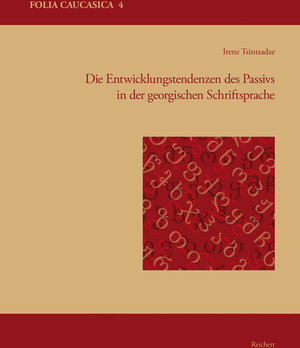
Die Entwicklungstendenzen des Passivs in der georgischen Schriftsprache
von Irene Tsintsadze
This book is a study of the so-called ‘dynamic’ synthetic passive and the tendencies of its development in the history of Georgian, the most prominent autochthonous South Caucasian (Kartvelian) language, which is of a more general interest: it has a 1500 years old written tradition and in many respects differs from the standard average European type, and its
system of verbal diathesis is particularly complex. Among the many remarkable typological features of Georgian, the passive deserves special attention. While the passive in the European languages can mostly or exclusively be regarded as a form of ‘conversion’ of corresponding transitive active forms, there is a very large number of passives in Georgian which are neither derived from actives nor even directly opposed to actives. The principle of ‘conversion’, i.e. of the transformation of active
sentences into passive constructions according to the model of traditional grammar, assumes that a given ‘direct object’ becomes a ‘subject’ and the underlying subject will be either eliminated or relegated into an adpositional phrase. While this process is relatively easy to describe in the Indo-European languages of the European type, where the subject is easily
identifiable by the criteria of the nominative subject case and of person-number agreement with the finite verb, the establishment of corresponding features for Georgian is much more complex, in a language with e.g. ‘split ergativity’ in which nominative and ergative constructions are distributed in relation to certain tense forms of transitive verbs. Considering the significance of the Georgian verb for the general linguistic discussion among Non-Kartvelologists, an introductory section of the book gives an outline of Georgian, its history and the fundamentals of its morphology and syntax. The extensive autochthonous linguistic literature on the passive is reviewed, critically examined and thereby made accessible to a broader public of linguists. The book deals with theoretical fundamentals, which are eminently important in connection with the Georgian passive, such as the encoding of syntactic relations in the sentence, the concept of ‘subject’, the paradigms of diathesis and valence, and the distinction between inflectional and derivational morphology. Furthermore, various subgroups of dynamic passives are examined with regard to their grammatical, logical, pragmatic, communicative and lexical-stylistic functions. On the basis of examples from the oldest translations of the Georgian Bible, the investigation seek to ascertain the
extent to which the use of passive forms in ancient Georgian literature can be used to prove possible influences or superstratum effects of the dominant Greek source language. From the perspective of general linguistics, it is a noteworthy fact that in the diachronic development from Old to Modern Georgian, an increase of suffixed passive formations and a simultaneous decline of prefixed types can be observed, which is documented by a broad-based research corpus.
Diese Monographie behandelt das Handlungspassiv und seine Entwicklungstendenzen im Georgischen, der prominentesten autochthonen südkaukasischen (kartwelischen) Sprache, die durch ihre lange schriftliche Überlieferung von 1500 Jahren, durch ihre Abweichung vom europäischen Standardtyp und durch die Komplexität ihrer verbalen Diathesen von
allgemeinerem Interesse ist. Im Hinblick auf die zahlreichen typologischen Auffälligkeiten des Georgischen verdient das Passiv ein besonderes Augenmerk. Angesichts der Bedeutung des georgischen Verbs für die allgemein-sprachwissenschaftliche Diskussion werden für Nicht-Kartvelologen in einleitenden Abschnitten des Buches das Georgische, seine Geschichte und die Grundlagen der georgischen Morphologie und Syntax skizziert. In der Monographie ist die umfangreiche autochthone Sekundärliteratur zum Passiv gesichtet, kritisch beleuchtet und der westlichen Linguistik damit zugänglich gemacht.
Während das Passiv in den europäischen Sprachen meist ausschließlich oder primär als ‚Konversionsform‘ entsprechender transitiver Aktivformen gelten kann, gibt es im Georgischen eine sehr große Zahl nicht von Aktiva abgeleiteter oder diesen
gegenüberstehender Passiva. Das Prinzip der ‚Konversion‘, d.h. der Transformation von Passivkonstruktionen aus Aktivsätzen nach dem Vorbild der traditionellen Grammatik, setzt voraus, dass ein gegebenes ‚direktes Objekt‘ zum ‚Subjekt‘ wird und das ursprüngliche Subjekt entweder eliminiert oder in eine Prä- bzw. Postpositionalphrase ‚abgedrängt‘ wird. Während dieser Vorgang in den indogermanischen Sprachen des europäischen Typs relativ leicht beschreibbar ist, da hier das Subjekt jeweils an zwei klaren Merkmalen erkennbar ist, nämlich dem Kasus Nominativ und der Personen-Numeruskongruenz mit dem finiten Verb, ist die Aufstellung entsprechender Merkmale im Georgischen, als in einer Sprache mit‚ gespaltener Ergativität‘, in der Nominativ- und Ergativkonstruktionen in Bezug auf bestimmte Tempusformen transitiver Verben distribuiert sind, wesentlich komplexer. Die Arbeit behandelt die theoretischen Grundlagen, die im Zusammenhang mit dem georgischen Passiv eminent wichtig sind, wie z.B. die Codierung von Relationen im Satz, den Subjektbegriff im Georgischen, Diathese und Valenzparadigmata, Flexions- vs. Derivationsmorphologie. Untersucht werden des Weiteren verschiedene Untergruppen sog.
synthetischer Handlungspassiva des Georgischen hinsichtlich ihrer grammatisch-logischen, pragmatisch-kommunikativen und lexikalisch-stilistischen Funktionen. An Beispielen aus der Bibelübersetzung wird darüber hinaus versucht zu eruieren, inwieweit sich im altgeorgischen Schrifttum im Gebrauch von Passivformen eventuelle Einflüsse bzw. Superstrat-Effekte des Griechischen als der primären, dominierenden Vorlagesprache nachweisen lassen. Die Arbeit geht dabei u.a. der auch aus allgemein-sprachwissenschaftlicher Sicht höchst bemerkenswerten Tatsache nach, dass sich in der diachronen Entwicklung vom Alt- zum Neugeorgischen ein Vordringen suffixaler Passivbildungen bei gleichzeitigem Rückgang präfigierter Typen feststellen lässt, was durch das breit angelegte Untersuchungscorpus dokumentiert wird.






